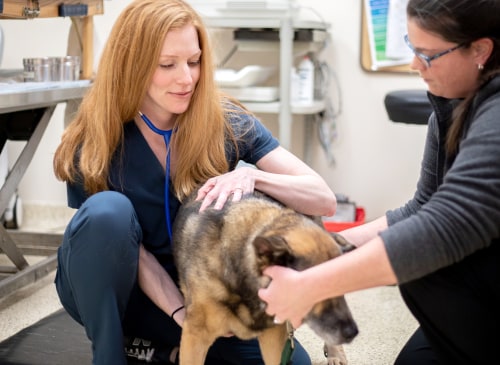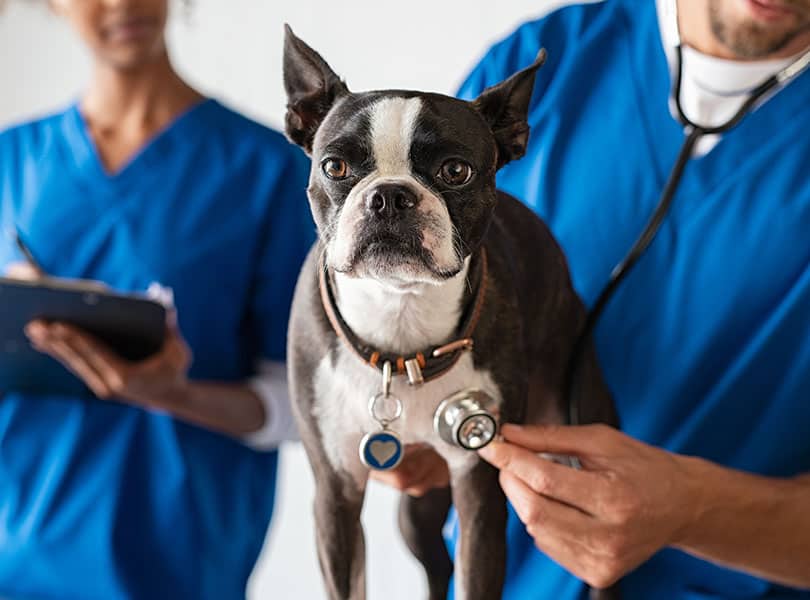The Function of Ultrasound and CT Scan in Modern Vet Practices: Insights From Experienced Professionals
In modern-day vet practices, ultrasound and CT scans significantly enhance diagnostic capabilities. These imaging strategies supply critical insights into animal health and wellness, assisting therapy choices. Experienced professionals acknowledge the unique advantages of each method. Ultrasound provides real-time assessments, while CT scans supply detailed physiological details. Comprehending their duties and applications elevates crucial concerns about their influence on person results and the future of vet diagnostics. What insights can be acquired from their incorporated usage?
Comprehending Ultrasound in Veterinary Medicine
Ultrasound is an important diagnostic device in veterinary medication, providing a non-invasive technique to visualize interior structures. This imaging method employs high-frequency acoustic waves to produce real-time pictures of tissues and body organs, permitting vets to assess problems without surgical intervention. Typical applications consist of assessing the heart, liver, kidneys, and reproductive organs, in addition to monitoring pregnancies.The procedure is reasonably fast and can be executed in various setups, making it an accessible option for veterinarians. Unlike radiography, ultrasound offers detailed info regarding soft tissues and blood flow, which is essential for accurate diagnoses.Veterinary experts count on ultrasound to detect problems such as lumps, cysts, and liquid build-up. Its capacity to guide biopsies and other procedures further improves its utility in professional technique. By supplying a efficient and risk-free means to examine internal anatomy, ultrasound has come to be a keystone of modern vet diagnostics.
The Advantages of CT Checks for Animal Diagnostics
CT scans offer significant benefits in veterinary diagnostics by giving boosted accuracy in identifying inner conditions (Board Certified Veterinary Cardiologist). As a non-invasive imaging method, they ensure the safety and convenience of pets during examinations. On top of that, CT scans assist in a thorough assessment of interior frameworks, enabling for extra effective treatment preparation
Enhanced Diagnostic Precision
Innovations in imaging innovation have actually significantly improved analysis accuracy in veterinary medication, especially with making use of CT scans. These scans give in-depth cross-sectional photos of a pet's internal frameworks, permitting veterinarians to determine abnormalities with precision. The high resolution and three-dimensional abilities of CT imaging assist in the detection of conditions such as growths, fractures, and interior blood loss that could be missed with conventional imaging methods. Additionally, CT scans can aid in pre-surgical preparation by using a comprehensive sight of physiological relationships. This level of detail not only boosts the accuracy of diagnoses yet additionally help in customizing effective therapy strategies. The assimilation of CT modern technology into vet methods is transforming the landscape of pet health care, boosting results for individuals.
Non-Invasive Imaging Technique
The intro of non-invasive imaging strategies has revolutionized animal diagnostics, with CT scans becoming a prominent tool in veterinary practices. These scans provide high-resolution, cross-sectional pictures of a pet's interior frameworks, allowing vets to analyze complicated problems without the need for invasive procedures. The benefits of CT scans include their capability to identify growths, fractures, and interior bleeding with impressive precision. Furthermore, they facilitate the examination of soft cells and organs, boosting diagnostic capacities. The speed of CT scanning enables quick decision-making, which is crucial in emergency situation scenarios. By lessening stress and anxiety and discomfort for the animal, CT scans add to a much more gentle strategy to diagnostics, inevitably boosting therapy outcomes and advancing vet care.
Comprehensive Internal Analysis
A complete internal assessment is essential for exact diagnosis and effective treatment in vet medication. CT checks offer significant benefits hereof, giving comprehensive cross-sectional photos of a pet's inner structures. This sophisticated imaging technique boosts visualization of intricate physiological regions, making it possible for veterinarians to determine abnormalities such as growths, cracks, and internal blood loss with higher precision. Additionally, CT checks facilitate the assessment of problems that may be testing to detect through typical approaches. The speed and accuracy of CT imaging additionally contribute to prompt treatments, boosting client outcomes. As veterinary practices progressively include CT technology, the benefits of comprehensive inner analyses come to be obvious, reinforcing the importance of this tool in contemporary vet diagnostics.
Comparing Ultrasound and CT Imaging Techniques
While both ultrasound and CT imaging serve essential duties in veterinary diagnostics, each strategy provides distinctive advantages and constraints that can influence professional decision-making. Ultrasound is especially valued for its real-time imaging capabilities, allowing vets to observe vibrant physiological processes. This method is non-invasive, mobile, and does not include ionizing radiation, making it a more secure option for both clinicians and animals. Ultrasound might have constraints in imagining particular physiological structures or deep tissues.Conversely, CT imaging offers in-depth cross-sectional sights of the body, allowing for exact localization of problems. It stands out in assessing facility organs and frameworks, particularly in the thorax and abdomen. CT scans require sedation or anesthetic in several cases and include exposure to ionizing radiation. Inevitably, the choice in between ultrasound and CT depends on the specific medical circumstance, the area of rate of interest, and the seriousness of the diagnostic needs.
Situation Researches: Effective Diagnoses Through Imaging
Study highlight the significant improvements in diagnostic precision achieved through sophisticated imaging modern technologies like ultrasound and CT scans in vet techniques. These innovations not only improve the detection of numerous conditions yet likewise facilitate effective and timely treatment plans. Assessing specific situations can highlight the transformative influence of these imaging techniques on veterinary medication.
Analysis Precision Improvements

Imaging Modern Technology Advancements
As vet imaging technology remains to develop, its effect on analysis capabilities comes to be significantly obvious. Current situation research studies highlight the successful application of innovative ultrasound and CT scan strategies in determining complex problems. A veterinary facility made use of high-resolution CT scans to identify an uncommon form of lung cancer cells in a pet, which conventional imaging had missed out on. In a similar way, an ultrasound evaluation revealed a stomach mass in a pet cat, triggering timely medical treatment and a positive outcome. These advancements not just boost analysis precision yet likewise allow vets to devise targeted treatment strategies. By leveraging innovative imaging technologies, vet professionals are significantly boosting patient care, bring about a lot more reliable monitoring of various wellness conditions in pets.
The Role of Imaging in Emergency Situation Vet Care
Imaging plays an essential role in emergency situation vet care, supplying vets with crucial details needed to make rapid, enlightened choices. In immediate situations, methods like ultrasound and CT scans make it possible for specialists to quickly evaluate a pet dog's internal frameworks, recognizing essential conditions such as internal bleeding, fractures, or body organ problems. These imaging modalities enable real-time assessments, assisting in timely treatments that can be life-saving. Ultrasound is very useful for examining soft cells injuries and conditions like imp source fluid buildup, while CT scans deal thorough pictures of intricate physiological frameworks, essential for identifying injury situations. The rate and precision of these imaging methods boost the veterinarian's capability to devise efficient therapy strategies, ensuring the very best feasible end results for their patients. Consequently, the combination of sophisticated imaging innovations right into emergency situation vet methods is not just valuable yet increasingly needed, as it enhances diagnostic capabilities and boosts overall pet care throughout vital moments.
Training and Knowledge in Veterinary Imaging
Advanced imaging techniques such as ultrasound and CT scans are necessary for effective veterinary care, the effective application of these technologies greatly depends on the training Visit This Link and expertise of vet specialists. Competent use of imaging devices needs comprehensive knowledge of anatomy, pathology, and the principles underlying each method. Veterinary experts have to undergo customized training to accurately translate imaging outcomes, which is crucial for diagnosing problems and preparing treatment.Certifications and proceeding education and learning in vet imaging enhance the skills of practitioners, enabling them to remain upgraded with technological developments. Collaboration between radiologists and vets typically brings about boosted analysis precision, as experts can give insights into complicated cases. In enhancement, functional experience in taking care of imaging devices cultivates self-confidence in its application. Eventually, the high quality of vet imaging services is straight associated to the degree of training and know-how had by the professionals using these important diagnostic devices.
Future Patterns in Diagnostic Imaging for Animals
With the fast developments in technology, vet analysis imaging is poised for substantial advancement in the coming years. Arising fads suggest a change towards even more accessible and portable imaging methods, such as portable ultrasound tools, which might improve area diagnostics. Furthermore, the assimilation of artificial intelligence is expected to reinvent photo evaluation, enabling quicker and much more accurate analyses of results.Moreover, advancements in 3D imaging strategies and calculated tomography will certainly supply vets with more detailed sights of pet makeup, resulting in better therapy plans. Digital fact modern technology might likewise contribute in surgical preparation and education and learning, providing veterinarians a special viewpoint on complex cases.As telemedicine proceeds to expand, remote assessments facilitated by diagnostic imaging will end up being a lot more common, allowing experts to aid basic specialists in real-time. On the whole, these trends are readied to improve the efficiency and performance of veterinary care, ultimately improving animal end results.
Regularly Asked Inquiries
Just How Much Do Ultrasound and CT Checks Cost in Veterinary Centers?
The costs of ultrasound and CT scans in veterinary clinics commonly vary from $300 to $1,500, relying on factors such as place, clinic kind, and certain procedures needed for the animal's medical diagnosis and therapy.

Are There Any Dangers Connected With Ultrasound and CT Checks for Pets?
Ultrasound and CT scans typically pose very little risks to family pets. Possible concerns include sedation responses and exposure to anesthetics. Veterinarians meticulously analyze each situation to reduce any kind of risks connected with these analysis treatments
For How Long Do Ultrasound and CT Procedures Usually Take?
Ultrasound procedures normally take around thirty minutes to an hour, depending upon the intricacy. CT scans, being more in-depth, typically call for thirty minutes to 90 minutes, consisting of prep work and recovery time for the pet.
Can All Veterinarians Perform Ultrasounds and CT Scans?
Not all vets can do ultrasounds and CT scans. Specialized training and qualification are usually required to guarantee competency in these advanced imaging methods, which may limit their schedule to vets with added credentials and sources.
What Sorts Of Pets Benefit A Lot Of From These Imaging Techniques?
Specific pet varieties, particularly canines and felines, advantage substantially from ultrasound and CT scans. These imaging techniques improve analysis accuracy for conditions like lumps, inner injuries, and body organ irregularities, bring about enhanced treatment end results and patient care. read this post here The high resolution and three-dimensional capacities of CT imaging promote the discovery of problems such as tumors, cracks, and interior blood loss that may be missed with standard imaging approaches. Instance researches highlight the considerable renovations in analysis precision achieved via innovative imaging modern technologies like ultrasound and CT scans in vet techniques. Improving diagnostic accuracy in vet methods has been considerably helped by improvements in imaging innovations such as ultrasound and CT scans. Advanced imaging strategies such as ultrasound and CT scans are important for effective vet treatment, the effective implementation of these modern technologies greatly depends on the training and expertise of vet experts. Veterinary professionals have to undertake specialized training to accurately analyze imaging results, which is important for diagnosing conditions and preparing treatment.Certifications and proceeding education in veterinary imaging enhance the abilities of experts, allowing them to stay upgraded with technological developments.